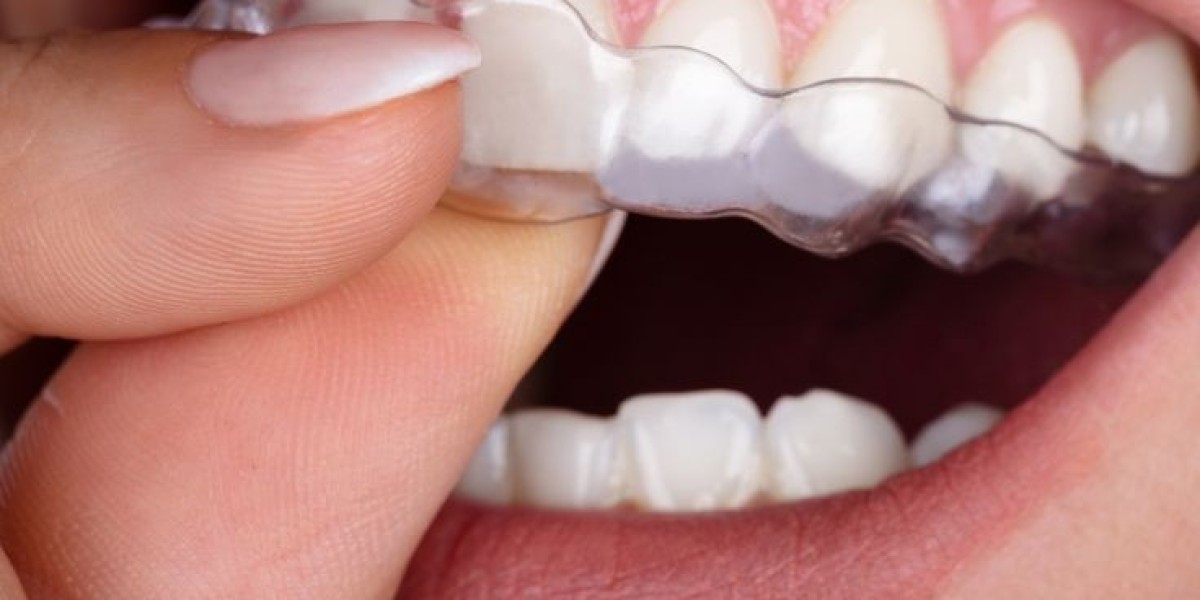In the world of orthodontics, clear braces have emerged as a popular choice for individuals seeking to straighten their teeth without the conspicuous appearance of traditional metal braces. Offering a blend of aesthetic appeal and effectiveness, clear braces are transforming smiles and boosting confidence for people of all ages. This article delves into the intricacies of clear braces, exploring how they work, their benefits, considerations, and aftercare tips.
What Are Clear Braces?
Clear braces are an orthodontic treatment designed to straighten teeth and correct bite issues, much like traditional metal braces. The key difference lies in their appearance: clear braces are made from transparent or tooth-coloured materials, making them far less noticeable. There are two main types of clear braces:
Clear Ceramic Braces: These braces function similarly to traditional metal braces, with brackets and wires. However, the brackets are made from ceramic, a tooth-coloured material, and the wires may also be tooth-coloured to blend in more seamlessly with the teeth.
Clear Aligners: Also known as invisible aligners, these are a series of custom-made, removable trays that fit snugly over the teeth. Brands like Invisalign have popularised this form of treatment. The aligners are made from clear plastic, making them virtually invisible.
How Do Clear Braces Work?
The process of straightening teeth with clear braces is similar to that of traditional braces but with some key differences depending on the type of clear braces used.
Clear Ceramic Braces
Clear ceramic braces work by applying continuous pressure to the teeth, gradually moving them into the desired position. Here’s a breakdown of the process:
Initial Consultation: The process begins with a consultation with an orthodontist, who will evaluate your teeth and determine if clear ceramic braces are suitable for your needs.
Customisation: If you opt for clear ceramic braces, the orthodontist will create a treatment plan tailored to your specific dental requirements. The brackets will be customised to fit your teeth, and a wire will be threaded through them to guide the movement of the teeth.
Adjustment Period: Over time, the orthodontist will adjust the wires to maintain consistent pressure on the teeth, ensuring they move into the correct position. These adjustments typically occur every 4 to 6 weeks.
Completion: Once the teeth have moved into the desired position, the braces are removed, and a retainer is usually provided to maintain the results.
Clear Aligners
Clear aligners work differently from traditional braces, offering a more discreet and flexible approach to teeth straightening:
Initial Consultation: As with ceramic braces, the first step is a consultation with an orthodontist. They will take 3D scans or impressions of your teeth to create a series of custom aligners.
Aligner Series: You will receive a series of clear aligners, each designed to be worn for about two weeks. Each set of aligners gradually shifts the teeth closer to their final position.
Daily Wear: Clear aligners should be worn for 20-22 hours per day, removing them only for eating, drinking (anything other than water), brushing, and flossing.
Progress Check-ups: Periodic check-ups with your orthodontist will ensure the treatment is progressing as planned. New aligners will be provided as needed until the treatment is complete.
The Benefits of Clear Braces
Clear braces offer numerous advantages, making them a preferred option for many individuals seeking orthodontic treatment. Here are some key benefits:
Aesthetic Appeal
The most significant advantage of clear braces is their subtle appearance. Whether you choose ceramic braces or clear aligners, both options are far less noticeable than traditional metal braces. This makes them particularly appealing to adults and teenagers who may feel self-conscious about wearing braces.
Effective Treatment
Clear braces are just as effective as traditional braces in treating a wide range of orthodontic issues, including crowding, spacing, overbites, underbites, and crossbites. They can provide excellent results when worn as directed by the orthodontist.
Comfort
Clear aligners, in particular, offer a higher level of comfort compared to traditional braces. The smooth plastic material reduces the likelihood of irritation to the gums and cheeks, which can be a common issue with metal brackets and wires.
Removability (for Clear Aligners)
One of the key advantages of clear aligners is that they are removable. This allows for greater flexibility in daily activities, such as eating and oral hygiene. You can eat your favourite foods without worrying about damaging your braces, and brushing and flossing are much easier without brackets and wires in the way.
Minimal Impact on Lifestyle
Clear braces, particularly clear aligners, have a minimal impact on your lifestyle. Because they are nearly invisible, you can go about your daily activities without drawing attention to your orthodontic treatment. This is a significant advantage for those who need to maintain a professional appearance.
Shorter Treatment Time (in some cases)
In some cases, treatment with clear aligners can be faster than with traditional braces. This is particularly true for less complex cases, where clear aligners can achieve the desired results in a shorter period.
Considerations Before Choosing Clear Braces
While clear braces offer many benefits, there are some factors to consider before deciding if they are the right option for you:
Cost
Clear braces, particularly ceramic braces and clear aligners, can be more expensive than traditional metal braces. The higher cost is due to the materials used and the customisation required for aligners. It's important to consider your budget and whether your dental insurance covers the cost of clear braces.
Discipline with Aligners
Clear aligners require a high level of discipline. They must be worn for 20-22 hours per day to be effective, and you must remember to put them back in after eating or drinking. If you don't wear them as directed, the treatment may take longer or be less effective.
Staining (for Ceramic Braces)
Ceramic braces can be prone to staining, particularly if you consume foods and drinks like coffee, tea, red wine, or curry. While the ceramic material itself is stain-resistant, the elastic ties used to hold the wire in place can discolour over time, affecting the appearance of your braces.
Treatment Complexity
While clear braces are effective for most orthodontic cases, they may not be suitable for extremely complex cases. In such situations, traditional metal braces might be recommended by the orthodontist for better control and more predictable results.
Potential for Wear and Tear (for Aligners)
Clear aligners are made from durable plastic, but they are not indestructible. They can wear down over time, especially if you grind your teeth or don't handle them with care. You may need to replace them if they become damaged.
The Process of Getting Clear Braces
Understanding the process involved in getting clear braces can help you prepare for your orthodontic journey. Here's what you can expect:
Consultation and Assessment
The first step is to schedule a consultation with an orthodontist. During this appointment, the orthodontist will assess your dental condition, take X-rays, and possibly create a digital model of your teeth. They will discuss your treatment options and help you decide whether clear braces are the best choice for your needs.
Treatment Plan
Once you've decided on clear braces, your orthodontist will develop a customised treatment plan. For ceramic braces, this involves designing the brackets and selecting the appropriate wires. For clear aligners, the orthodontist will create a series of custom aligners based on the 3D model of your teeth.
Fitting the Braces or Aligners
If you're getting clear ceramic braces, your orthodontist will attach the brackets to your teeth using a special adhesive. The wires will then be threaded through the brackets and adjusted to start the process of moving your teeth.
For clear aligners, you will receive your first set of aligners and instructions on how to wear them. Typically, you'll change to a new set of aligners every two weeks.
Regular Check-Ups
Throughout your treatment, you'll need to visit your orthodontist regularly for check-ups. For ceramic braces, these appointments involve adjusting the wires and ensuring the braces are working as intended. For clear aligners, your orthodontist will monitor your progress and provide you with new aligners as needed.
Completion and Retention
Once your teeth have moved into their final positions, the braces or aligners will be removed. Your orthodontist will provide you with a retainer to wear, which is crucial for maintaining the results. Retainers help prevent your teeth from shifting back to their original positions.
Aftercare for Clear Braces
Proper aftercare is essential to ensure the success of your treatment and to maintain the appearance of your clear braces. Here are some tips for caring for your braces or aligners:
Oral Hygiene
Maintaining good oral hygiene is crucial when wearing clear braces. Brush your teeth at least twice a day and floss daily to remove plaque and food particles. For ceramic braces, you may need to use special tools like interdental brushes to clean around the brackets and wires. For clear aligners, clean them daily using a soft toothbrush and mild soap, and rinse them with lukewarm water.
Avoid Staining Foods and Drinks
To prevent staining of ceramic braces, avoid consuming foods and drinks that are prone to causing discolouration, such as coffee, tea, red wine, and tomato-based sauces. If you do consume these items, brush your teeth immediately afterward to minimise staining.
Handle Aligners with Care
If you're using clear aligners, handle them with care to avoid damaging them. Always store them in their case when not in use, and avoid exposing them to hot water, which can warp the plastic.
Follow Your Orthodontist’s Instructions
It's essential to follow your orthodontist's instructions closely, especially when it comes to wearing your aligners or attending adjustment appointments. Skipping appointments or not wearing your aligners as prescribed can prolong the treatment time or compromise the results.
Wear Your Retainer
After your treatment is complete, wearing a retainer is crucial to maintaining the position of your teeth. Your orthodontist will provide you with specific instructions on how often to wear your retainer. Neglecting to wear it can result in your teeth shifting back to their original positions, undoing the progress made during your treatment.
Who Is a Good Candidate for Clear Braces?
Clear braces are suitable for a wide range of individuals, but certain factors may influence your eligibility:
Mild to Moderate Dental Issues
Clear braces are ideal for individuals with mild to moderate dental issues, such as crowding, spacing, and minor bite problems. For more severe cases, traditional metal braces may be recommended.
Commitment to Treatment
Clear aligners require a high level of commitment. If you're someone who can adhere to wearing aligners for the recommended 20-22 hours per day and follow your orthodontist's instructions, you may be a good candidate.
Desire for Aesthetic Treatment
If you’re concerned about the appearance of traditional braces, clear braces offer a more discreet option. They are particularly popular among adults and teenagers who want to straighten their teeth without drawing attention to their orthodontic treatment.
Healthy Gums and Teeth
Good oral health is essential before starting any orthodontic treatment. If you have gum disease or untreated cavities, these issues will need to be addressed before you can begin wearing clear braces.
Conclusion
Clear braces have transformed the landscape of orthodontic treatment, offering an effective and aesthetically pleasing alternative to traditional metal braces. Whether you opt for clear ceramic braces or clear aligners, these modern solutions can help you achieve a straighter, more confident smile. While clear braces require commitment and care, their benefits make them an attractive option for individuals seeking to improve their dental health without compromising on appearance. With the guidance of a skilled orthodontist, clear braces can help you attain the smile you've always wanted.



